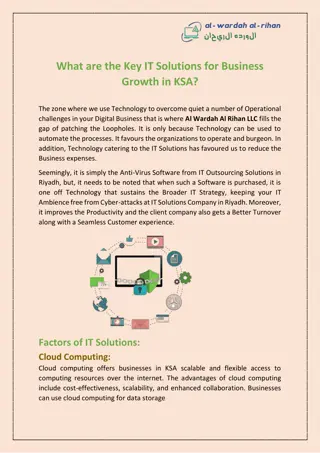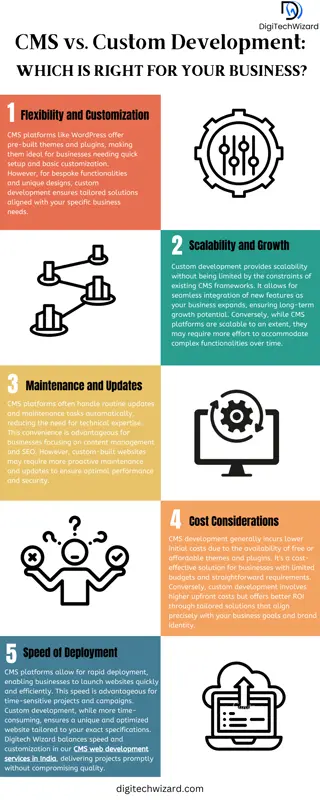
Co-Occurred Refactorings in Eclipse Usage Datasets Analysis
Explore the co-occurrence of refactorings in Eclipse usage datasets, uncovering common patterns and implications for software development efficiency and tool support. The study investigates frequently co-occurred refactoring types, shedding light on opportunities to enhance developer productivity and maintainability.
Download Presentation

Please find below an Image/Link to download the presentation.
The content on the website is provided AS IS for your information and personal use only. It may not be sold, licensed, or shared on other websites without obtaining consent from the author. If you encounter any issues during the download, it is possible that the publisher has removed the file from their server.
You are allowed to download the files provided on this website for personal or commercial use, subject to the condition that they are used lawfully. All files are the property of their respective owners.
The content on the website is provided AS IS for your information and personal use only. It may not be sold, licensed, or shared on other websites without obtaining consent from the author.
E N D
Presentation Transcript
What Kinds of Refactorings are Co-occurred? An Analysis of Eclipse Usage Datasets Tsubasa Saika1, Eunjong Choi1, Norihiro Yoshida2, Akira Goto1, Shusuke Haruna1, Katsuro Inoue1 1Osaka University, Japan 2Nagoya University, Japan 1 Software Engineering Laboratory, Department of Computer Science, Graduate School of Information Science and Technology, Osaka University
Refactoring Changing internal structure of software without altering theexternal behavior [1] Improving the maintainability of a software system Same external behavior Refactoring Complicated Source code Sophisticated Source code Easy to be maintained Developer 2 [1] M. Fowler Refactoring:Improving the Design of Existing Code. Addison Wesley 1999. Department of Computer Science, Graduate School of Information Science and Technology, Osaka University
Refactoring Support Tools Manually performed refactoring is not only time- consuming but also error-prone. [2] Several IDEs support many kinds of refactoring patterns. Eclipse, IntelliJ IDEA, NetBeans, etc. Use support tools Don t do by hand 3 [2] G. Bavota et al. When does a refactoring induce bugs? an empirical study. in Proc. of SCAM 2012 Department of Computer Science, Graduate School of Information Science and Technology, Osaka University
Related Work To improve refactoring support tools, Murphy-Hill et al. investigated Eclipse usage datasets. They found that developers often repeat same kinds of refactoring. [3] However, it has not been examined what different kinds of refactoring are frequently co-occurred in their datasets. 4 [3] E. Murphy-Hill et al. How we refactor, and how we know it, IEEE Trans. Softw. Eng., 2012 Department of Computer Science, Graduate School of Information Science and Technology, Osaka University
Example of Co-occurred Refactoring E.g.) Move and Rename A developer moves a class to another package and then renames its name consecutively. A developer needs to repeatedly select the class then invoke refactoring feature and configure its setting Step1 Moves the class to another package Package1 Package2 Move Rename ClassB.java ClassA.java ClassA.java Step2 Renames the class name 5 5 Department of Computer Science, Graduate School of Information Science and Technology, Osaka University
Research Motivation Existing refactoring support tools do not support consecutively co-occurred refactoring. Supporting co-occurred refactoring should improve software development efficiency. To develop the tool, the most frequently co-occurred refactoring should be clarified. 6 Department of Computer Science, Graduate School of Information Science and Technology, Osaka University
Overview of Research Investigated the refactoring tool usages Step1. Identifying frequency of co-occurred refactorings in the software development history Step2. Analyzing details of frequently co-occurred refactorings Devised suggestions for improving refactoring support tools based on the investigation results 7 Department of Computer Science, Graduate School of Information Science and Technology, Osaka University
Analyzed Datasets Usage data of Eclipse which includes usage logs of the refactoring features Users: usage record of Eclipse users [4] Mylyn: usage record of Mylyn plug-in developers Dataset name Users # developrs Period # performed refactoring 3494 # types of refactoring 22 41 Jul. 2005 Sep. 2005 Mylyn 8 4637 19 Feb. 2006 Aug. 2009 [4] G.C. Murphy et al. How Are Java Software Developers Using the Eclipse IDE? IEEE Software, 2006. 8 Department of Computer Science, Graduate School of Information Science and Technology, Osaka University
Step1: Identifying Frequently Co-occurred Refactorings 1. Identified co-occurred refactoring combinations regarded refactorings successively occurred within 90 seconds as co-occurred refactorings Within 90s Over 90s Rename Rename Move Developer Co-occurred Refactorings 2. Investigated the number of instances for each combinations of co-occurred refactorings 9 Department of Computer Science, Graduate School of Information Science and Technology, Osaka University
Frequently Co-occurred Refactoring rank refactoring 1 1Extract Method 2Extract Local Variable 3Extract Local Variable 4Extract Local Variable 5Move refactoring 2 Rename Rename Extract Method Inline Rename # performed Users 52 33 29 28 27 rank refactoring 1 1Move 2Move static Member 3Extract Constant 4Extract Interface 5Move refactoring 2 Rename Rename Rename Move Move static Member # performed Mylyn 115 21 14 14 12 Different combinations between Rename, Move, and Extract are the most frequent. 10 Department of Computer Science, Graduate School of Information Science and Technology, Osaka University
Step2: Details of Co-occurred Refactoring (1/2) Investigated details of frequently co-occurred refactorings to devise tool supports Only Mylyn dataset contains information about program elements altered by refactoring instances. Classified the targets of each refactoring into three types Same , Related , Others 11 Department of Computer Science, Graduate School of Information Science and Technology, Osaka University
Step2: Details of Co-occurred Refactoring (2/2) Same: each refactoring alters the same program element Related: targets have similar names or belong to the same package / class 1. Rename Field int number; int id; Similar Names int getNumber(){ return number; } int getId(){ return id; } 2. Rename Method 12 Department of Computer Science, Graduate School of Information Science and Technology, Osaka University
Result of Detailed Investigation refactoring 1 refactoring 1 refactoring 1 refactoring 2 refactoring 2 refactoring 2 # performed # Investigated # same # related # performed # Investigated # same # related # performed # Investigated # same # related 58 58 58 10 10 10 4 4 4 1 1 1 Move Move Move Rename Type Rename Type Rename Type Rename Field Rename Type Move Move Move Rename Method Rename Method Rename Package Rename Package Rename Package 48 32 29 29 29 10 10 10 10 10 0 0 1 1 1 5 4 7 7 7 48 32 32 10 10 10 0 0 0 5 4 4 Rename Field Rename Type Rename Type Rename Method Rename Method Rename Method Rename Field Rename Method 48 10 0 5 26 26 26 10 10 10 0 0 0 3 3 3 Rename Type Move Static Member Extract Interface Extract Interface Extract Interface Rename Field Rename Field Rename Field Rename Type Move Static Member Member Rename Type Move Static Rename Field Rename Field Rename Field 15 15 15 10 10 10 6 6 6 0 0 0 14 14 14 10 10 10 7 7 7 1 1 1 Move Move Move Rename Local Variable Variable Variable Rename Local Rename Local 12 12 12 10 10 10 0 0 0 6 6 6 Rename Field Rename Field Rename Field 13 Department of Computer Science, Graduate School of Information Science and Technology, Osaka University
Details of (Move, Rename) When targets are classified as Same Rename the program element that was previously moved mylyn.tasks.ui mylyn.internal.tasks.ui.properties Package Moves the class to other Package ProjectPreferences LinkProvider.java ProjectPreferences LinkProvider.java ProjectProperties LinkProvider.java Class Renames the class name 14 Department of Computer Science, Graduate School of Information Science and Technology, Osaka University
Suggestions for Supporting (Move, Rename) Providing feature that simultaneously supports Move and Rename Appending a text field for new name to the dialog of Move refactoring Dialog of Rename Refactoring Dialog of Move Refactoring 15 Department of Computer Science, Graduate School of Information Science and Technology, Osaka University
Details of (Rename, Rename) Rename refactorings are often performed together. regardless of types of targeted program elements altering Related program elements (similarly named) e.g.) Rename Field and Rename Local Variable TaskElementLabelProvider.java Rename Field compositeImages wideImages TaskElementLabelProvider( ){ compositeImages } Same Name Same Name wideImages Rename Local Variabe 16 Department of Computer Science, Graduate School of Information Science and Technology, Osaka University
Suggestions for Supporting (Rename, Rename) Developing a refactoring feature for renaming several program elements regardless of their types Currently only the Rename refactoring intended for class can update similarly named elements automatically. There is no such support for Rename refactoring intended for other types of program elements 17 Department of Computer Science, Graduate School of Information Science and Technology, Osaka University
Conclusion & Future Work Conclusions This study investigated consecutively co-occurred refactoring combinations. We devised suggestion for the improvement of the refactoring feature of Eclipse. Future Works Collecting additional datasets to achieve generality Developing and examining a refactoring support tool according to our investigation results 18 Department of Computer Science, Graduate School of Information Science and Technology, Osaka University











